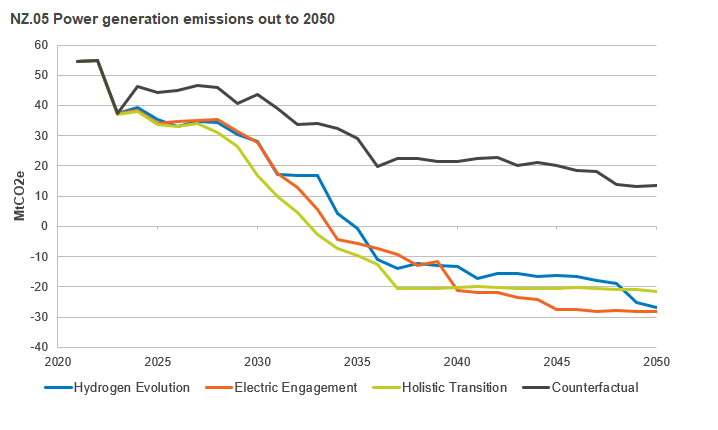If you were ever uncertain that Energy Secretary Ed Miliband and his Head of Mission Control, Chris Stark, were space cadets with only the vacuum of space between their ears, then the letter they sent to the National Grid ESO yesterday should remove all doubt.
First, it is rather unfortunate that the file name for the letter on the Government website is ‘SOS Chris Stark Letter Clean Power 2030’. It smacks of a certain amount of desperation. But it is the substance of the letter that is more worrying. They have written to Fintan Slye, Director of the National Grid ESO (soon to become NESO) for “practical advice” on achieving a clean power grid by 2030. In other words, neither Miliband nor Stark have the faintest clue how to deliver a Net Zero carbon grid by 2030.
The letter goes on to detail the advice they need, which includes a range of pathways to enable a decarbonised power system by 2030. For each pathway they ask that Slye sets out the energy generation and demand mix and the underlying assumptions that need to be met for these to be deliverable. They also ask for the key requirements for the transmission network and interconnectors. Interestingly, they do not ask for any information about the distribution network. They also ask for a high-level view of the costs, benefits, opportunities, challenges and risks as well as the key actions to be taken by Government, NESO, Ofgem and industry to enable delivery of the pathways. Stark’s post on X/Twitter says the advice will be delivered in the Autumn, so NESO has just three months to complete this work.
Labour’s Green Prosperity Plan was launched with some fanfare back in September 2022 and was put together for the party by Ember, the green energy think tank. Back then it was described as “ambitious but possible”, which is consultant-speak for completely barking. As I covered last year, the plan included completely unrealistic build-out plans for wind and solar power and was very sketchy on the amount of storage that would be required.
The letter from Miliband and Stark puts Fintan Slye in an exceedingly difficult position. Only last month, NG ESO launched its latest Future Energy Pathways (covered here) which were supposed to demonstrate a “a narrower range of outcomes to drive more strategic, credible routes to Net Zero”. The trouble is, all the “credible routes” included very significant CO2 emissions for power generation in 2030 (see Figure 1).
To comply with the request from Government, Slye and his team have to completely rehash this year’s FES “credible” pathways, deliver a completely new set of pathways and somehow pretend that the new pathways are plausible. The extra difficulty arises because FES2024 had it its own credibility problem because it called for a halving of per capita energy use by 2050, had deindustrialisation built in, assumed the use of as yet unproven and expensive technologies to deliver unrealistic amounts of hydrogen and relied upon carbon capture unicorns.
The change in FES 2024 from scenarios to pathways was supposed to bring in “additional economic modelling”, but such modelling was conspicuous by its absence. Now Slye must deliver the previously non-existent cost-benefit analysis for these new pathways within three months. That is a very tall order indeed.
The big question is whether NG ESO can maintain the pretence that a Net Zero grid by 2030 is achievable and economically viable and lose whatever remaining credibility it has, or will it be the first to point out that Mad Emperor Ed has no clothes?
David Turver writes the Eigen Values Substack page, where this article first appeared.












To join in with the discussion please make a donation to The Daily Sceptic.
Profanity and abuse will be removed and may lead to a permanent ban.
We left London for this reason amongst many. Schools that were rubbish which looked like they were in North Africa, the Middle East or Nigeria. Teachers that couldn’t speak English. Students who were hostile to Whites and anything English. Curricula that vilified our past and exalted the invaders. Muslim gangs. Hindu gangs. Gangs outside the secondary school at 3 pm, lifting phones, bikes, and wallets off of younger children. Gangs roaming our high street and buses causing issues and physically intimidating older people and store owners.
Import shyte, turn into shyte.
Our culture is like a bottle of diluting orange juice. When you keep adding water to it, it gradually over time becomes diluted until it isn’t orange juice anymore. It will soon be the case that our culture no longer exists it will have been diluted so much. —–Multiculture means NO CULTURE. Everyone who comes here never want to be called anything other than British. They become offended when you ask them where they are from. They reply with indignation “I am British” ———Ok then so act like it. Stop trying to turn Britain into the kind of place you and your parents fled from. You came here to be “free”. Do not abuse that freedom and turn Britain into the place you left.
I can’t stand this question, either, hence, I either don’t answer it or answer it with “For now, Reading.” But that’s probably just because this kind of cross-questioning of strangers is – for German standards – very impolite (a cultural difference between Germany and the UK). However, for some reason, I always answer the question “Are you German?” with “Yes” and always answer all “Are you …?” with “No, German” (level of annoyance proportional to the Polishness of the suggestion 🙂 … I have nothing against Poles per se, buty I’m emphatically not one).
If I ask the question “Where are you from”? It is because I am genuinely interested and will often want to know what that place is like or if I am familiar with that place I will be able to speak about having been there myself. But eg if you are very dark skinned (black) person that question it can sometimes be interpreted as you are implying that black person has no right to be here. That is insecurity on their part. Because what the person is really asking them is “where are you or your parents from originally”? ——-A person confident in themselves should have no problem answering this reasonable question. And if the answer happens to be “Nigeria” Then So What?
The usual “Are you Polish? (!!)” question certainly implies that as well. I’ve heard that one often enough. But we (thankfully) don’t have a “Polish Lives Matter!”-movement yet.
I realize that this is polite conversation in England but it really isn’t in Germany and the usual German answer to something like this would be “Geht dich’en Scheiß an!” (very vulgar from of “Shut up and mind your own business!”). Germans are not very sociable towards strangers.
“ Germans are not very sociable towards strangers.” Not our experience over 20+ years. I am not British – the only thing about me that is British is my passport.
How many of these 20+ years have you spent in small villages (<1000 inhabitants) or towns (<10,000 inhabitants) in rural areas? It’s about 26 years for me as I was born in one. On top of this come another 12 years in a German town notoriously hostile¹ ² to everyone who wasn’t born there.
¹ To the point were local band playing at supposedly public festivals openly demand that all “outsiders” must now leave immediately.
² The furuncle at the underbelly of Wiesbaden called Mainz. My mother was born there which is probably more than many Mainzer can say of themselves. But nevertheless, the only thing this place is really good for is above ground testing of nuclear warheads.
Oddly enough, it was when I lived opposite Pimlico School from 1973-5 (in a dreadful medical school hostel) that I witnessed one of only two racist incidents in all the time I was in London.
As I left the hostel, a football came over the wall of the school playground, and I heard a distinctly West Indian child’s voice inside shout, “Go and get it, you dirty little Paki.”
The other incident? That was when a small black girl stepped into the road to try and push me off my bike as I cycled along South Lambeth Road.
Back in the early 1970s at a school I attended, one of the deputy headmasters banned sixth-formers from wearing black shirts as they were ‘reminiscent of the fascist Black Shirts of the 1930s’.
This school, by that time an amalgamation of two others brought about when Thatcher was education secretary in Heath’s government, had evidently become more progressive since the mid-1960s when some sixth-formers still wore short trousers and caps.
https://www.conservativewoman.co.uk/democracy-in-decay-the-return-of-blair/
John Wycliffe at TCW with a lightweight description of the damage done to this country by Bliar and how it will get worse after Kneel’s triumph. Well he got the last bit correct.
We are not a Nation anymore. We are just a Region. ——-The horse has bolted. It is too late. The traitors have sold out to globalist politics. ——-Funny we don’t see migrants flooding into Japan though. Those racist Japanese need to become more diverse what?
Same in most countries. Here’s a glimpse of Lisbon, Portugal. How he’s managed to walk past all of them immigrants saying all of those things without getting attacked is quite an achievement, although it’s presumably because they can’t speak the language so he can say what he likes. Another holiday destination off my list, similarly with the Canaries. They’ve all been and are being invaded 🙁 ( <2mins );
https://twitter.com/DaveAtherton20/status/1755539041892589619
It is indeed outrageous that just about everyone living on this planet has full voting rights in the UK (ie, all citizens of commonwealth states who are legally in Britain at the time of the vote) and that this enormous global south power block could be diluted by granting a right to vote to legally resident white people from Europe. If Wycliffe calls this granting a right to vote to foreign nationals, he’s lying by omission. Foreign nationals do have a right to vote in the UK provided they have the proper skin colour and pedigree. Even with temporary leave to remain.
Re’ your last paragraph–‘I’d much rather be living in England again’–. Haven’t you noticed, the England you crave disappeared over the horizon thirty plus years ago. Londonistan is the petri dish for what’s coming to the rest of the county—–rapidly. The England I grew up during the 50s and 60s in but a faded memory.
By criticising Ms Birbalsingh, (indeed your previous article all but demonised her), you are de facto giving the Pimlico school an easier ride than it deserves.. Were I a parent, unfortunate enough to be living in London, and having to chose between Pimlico and the Michaela school, I’d go for the latter 100 times out of 100, as it more closely resembles the school I attended in it’s pursuit of academic achievement and personal development. Regarding Ms Birbalsingh’s methods, ‘Needs must when the devil drives.’
“I say old chap” has turned into “Wats up Bro”——–Turn the light off will you.
Not in my universe it hasn’t varmint old bean.
Well I’d never heard of this French chap but already I like him because he talks sense and says it like it is. This article and video is based on his opinions re immigration and his observations from a recent visit to London;
”In a visit that has angered globalists, former French presidential candidate Éric Zemmour and the leader of the Reconquête party recently embarked on a high-profile trip to London, arriving via the Eurostar station in Saint-Pancras on Friday, January 26. Zemmour’s visit to the troubled British capital was far from ordinary, as it served as a platform for him to engage in discussions with British intellectuals and take part in a contentious debate surrounding the UK’s immigration legislation, currently under consideration in the House of Lords.
The central tenet of Zemmour’s message was clear from the outset: “For London to remain London and France to remain France, our two nations must fight together against the Islamization of Europe.” He stressed that the Islamization of European cities is a pressing issue that requires immediate attention and collective action.
Throughout his visit, Zemmour did not shy away from expressing his concerns and views on shared crises between France and the UK, including identity, migration, and economic challenges. He stressed that these challenges necessitate a collaborative effort between the two nations.
In the video, Zemmour articulated his perspective on cultural integration, saying, “It completely destroys [Jean-Luc] Mélenchon’s theory. There is no creolization; there is no miscegenation. There is just one culture that replaces another, that’s all.” He boldly asserted that in Islam, mosques are not just places of worship but instruments of territorial conquest. “Wherever there is a mosque, that’s Islamic land,” he proclaimed.”
https://rairfoundation.com/must-watch-eric-zemmours-explosive-london-visit-exposing/
Read “While Europe Slept” and/or “Surrender” by Bruce Bawer.
Yes but let’s just be honest for a sec…Is your real name ‘Bruce Bawer’? 🕵♀️🥸
https://www.conservativewoman.co.uk/grant-shapps-and-the-killing-of-port-talbot/
5,000 jobs to be lost directly and I would bet as many again across the supporting economy.
The destruction of Britain.
Core point: This Net Zero pointscoring actually increases global CO₂ ’emissions’ as running blast furnace elsewhere obviously doesn’t decrease them and importing the products also causes CO₂ ’emissions’ due to transport.
Conclusion (again): The people behind this project absolutely don’t believe it’s necessary. Just like the Greens who claim that deforestation in Brazil is really evil whenever the president comes from the wrong party and who also claim that hacking down centuries-old forests in Europe to make space for more subsidized windmills would be Good for the planet (code language for: It’s bad for the people living in the windmilled areas but WE care about much more important things!)
You’re quite right. The removal of primary & secondary industries, and skilled labour only increases domestic poverty within that country. The reliance on public sector, government workers and hospitality with part time and flexible time workers, for the survival of the economy, supported by government borrowing is the death throws of the nation. The West (USA, EU & UK) are all seeking more inventive ways of borrowing money, and at present, the EU is probably leading the way.
The Plimico event was certainly engineered by a coalition of teachers, councillors, journalists, parents and a few MPs who all used pupils as their shock troops. Kids simply don’t speak adult-labourese (or labour-adulterese) unless taught to, probably by having them memorize the phrases. They’re usually more interested in consensual (one hopes) close-combat with members of another sex than in flags schools are flying or not flying.
Ironic that many came here for a better life with free education for their children and now any teacher will be too scared to teach there which will lead to far more social problems.
Without the white race to blame they will turn on each other and the most violent will take over.
I don’t think there is much going on at the Michaela school that you would not find in most successful schools in different parts of the world, particularly (unsurprisingly, that’s really one of the main things parents pay for in the private sector).
‘The French do not tolerate misbehaving students. Despite the more flexible reputation the French have garnered, French teachers approach discipline with a firm hand.
In my experience, chatty kids were simply considered intolerable. When students disrupted the class, teachers called them out, instructed them to sit on their hands, had them face the wall, or simply banished them from the classroom…..
As such, the children behaved better than any students I’ve witnessed in American schools.’
Alexandria Rogers: An experience in the French education system
Of course what is really unusual about the Michaela school are the stellar academic results….and that is what (just about) all the parents want.
The idea that that translates across to British politics seems a strange idea.
‘…..the temptation for electorates will only grow ever stronger to one day vote in a Michaela-type figure who promises to end at last the ruinous war of all against all by curtailing the liberties of everyone for the sake of the ‘greater good’
Already happened: Major 42% Blair/Brown 43% May 42% Corbyn 40% Bunter 42%
Socialist fascists the lot of ’em……….
The point about teachers and discipline is simple: Stupid laws have made life impossible for teachers. We need to bring back detentions, lines and canes. Or if this is unacceptable the ability to fine parents for pupils bad or disruptive behaviour. Simple enough, won’t happen though. Politicians want a completely uneducated population who can be manipulated. Surely the reason for the huge reduction in educational standards from Infants to PhDs!
Enoch,s point cannot be argued against anymore !
Have you seen the funeral on London Bridge !!